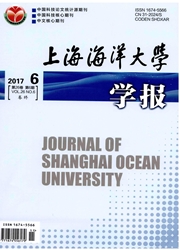

 中文摘要:
中文摘要:
长江野生扣蟹在成蟹养殖阶段具有优异的养殖性能,但是野生大眼幼体在成蟹养殖阶段的养殖效果却不清楚。因此,本研究系统比较了野生和人工繁育大眼幼体养成的扣蟹(蟹种)在成蟹养殖阶段的生长、性腺发育、成活率、产量、饲料系数、成蟹平均体重及规格分布。结果显示:(1)无论是雌蟹还是雄蟹,野生群体中后期的平均体重显著大于人工繁育群体。野生群体雄蟹在5-6月和7-8月增重率(WGR)和特定生长率(SGR)显著高于人工繁育群体,野生群体雌蟹在8-9月WGR和SGR也显著高于后者(P〈0.05)。(2)尽管野生群体最终成蟹规格显著大于人工繁育群体(P〈0.05),但成活率略低于人工繁育群体,故两群体的最终成蟹产量基本一致(P〉0.05)。(3)就最终成蟹规格分布而言,野生群体大规格雄蟹(体重≥175 g)和雌蟹(体重≥125 g)比例多于人工繁育群体,而中等规格雄蟹(体重125~174.9 g)和雌蟹(体重100~124.9 g)的比例低于人工繁育群体。因此,长江水系野生大眼幼体在成蟹阶段的养殖性能优于人工繁育大眼幼体,可以进一步发掘其优异种质资源,进行中华绒螯蟹良种培育。
 英文摘要:
英文摘要:
Although the wild Yangtze Eriocheir sinensis juveniles (coin-sized seed) have the better culture performance than the artifically pond-reared juveniles during the adult crab breeding stage, the culture performance of wild-caught megalopae was largely unclear. Therefore, this study was designed to compare the growth, gonadal development, survival, crab yield, feed conversion rate (FCR), final mean body weight and size distribution between wild population (WP) and artificial breeding population (AP) of E. sinensis megalopae for the Yangtze population during the adult crab culture stage. The results show that: despite of males or females, the mean body weight of WP was significantly higher than that of AP during the mid-late culture stage. It was the evidence that the males of WP had the significantly higher body weight gain rate (WGR) and specific growth rate (SGR) than those of AP duiring the periods of May-July and July-August, while the females of WP had the significantly higher WGR and SGR than those of AP duiring the period of August-September (P 〈 0.05). Although WP had the significantly higher final mean body weight than AP, the AP had a slightly higher survival than WP, leading to the similar crab yeilds between two populations. As for the size distribution of adult crabs, WP had the higher percentage of large size crabs ( male ≥ 175 g; female ≥125 g), but the lower proportion of middle size crabs (male: 125 - 174.9 g; female: 100 - 124.9 g) than AP for both males and females. In conclusion, wild -caught megalopae of Yangtze E. sinensis had the better culture performance than the artificial breeding population, and the selective breeding program of Yangtze E. sinensis could be based on the wild populations by the exploitation and enhancement of their excellent germplasm resources.
 同期刊论文项目
同期刊论文项目
 同项目期刊论文
同项目期刊论文
 期刊信息
期刊信息
